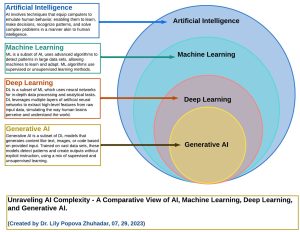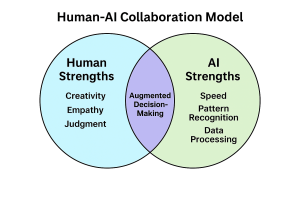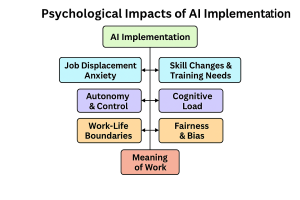9-2: Artificial Intelligence in the Workplace
Now, let’s talk about the game-changer: Artificial Intelligence (AI). At its core, AI refers to machines programmed to simulate human intelligence — to think and learn like humans do. The advancement of AI has always depended on computer speed and power, which explains its rapid evolution and increasing presence in our lives.
Here’s something that might blow your mind: the decisions being made right now about how AI is used in the workplace will have lasting impacts on success and society for centuries. No pressure, right?
AI is already transforming virtually every aspect of our lives and workplaces. It can create images, work with audio, transcribe speech in real-time, make data-driven decisions, and translate between human languages. It’s not science fiction anymore — it’s your current reality.
According to McKinsey’s 2025 research, 88% of C-suite executives globally say helping their business speed up adoption of AI will be important over the next year, with the long-term AI opportunity sized at $4.4 trillion in added productivity growth potential from corporate use cases.
Common workplace applications include:
Automation involves AI-powered robots and software handling repetitive, dangerous, or mundane tasks. Think manufacturing assembly lines, data entry, and customer service chatbots that actually understand what you’re asking.
Decision Support Systems use AI algorithms to analyze massive datasets and provide insights and recommendations for human decision-makers. These are used in finance, healthcare, and HR to help humans make better-informed decisions.
Intelligent Assistants are AI tools that augment human capabilities by providing information, scheduling, or communication support. Siri and Alexa are consumer examples, but workplace versions are much more sophisticated.
Predictive Analytics involves AI models forecasting future trends or behaviors — like predicting employee turnover, sales trends, or equipment failures before they happen.

Types of AI Relevant to the Workplace
Businesses can choose from different AI technologies to enhance, support, simplify, modify, or even automate certain processes.
Machine Learning (ML)
Machine Learning (ML) is where an algorithm executes a task, remembers the output, and integrates that information to update its own instructions for better, more efficient output next time. The power of machine learning is that it allows us to create models and train them gradually so they can ultimately yield desired results. It’s like having a system that gets better at its job through experience.
Natural Language Processing (NLP)
Natural Language Processing (NLP) refers to a computer’s ability to understand human language, both written and spoken. A chatbot, for example, looks at past natural language search data and available responses to formulate reasonable, “human-like” responses. It’s what makes it possible for you to type a question in normal language and get a helpful answer.
Generative AI
Generative AI is where things get really interesting — this is AI that begins to mimic human intelligence and, in many cases, can exceed it. ChatGPT (Generative Pre-Trained Transformer) is a common example. It was pre-trained on vast amounts of data to communicate effectively. Being generative, it responds to and creates content when requested, producing conversational, natural language responses based on the massive volume of human-created input data it has absorbed. Businesses can retrain its algorithms on their own data to generate specific responses, allowing it to scan huge volumes of existing data, identify patterns, and produce entirely “new” output.
Predictive Analytics
Predictive Analytics involves drawing upon large amounts of measured data, analyzing it, and developing models to create new outputs like predictive models and simulations. For instance, using tools in a spreadsheet program to reveal trends in large datasets employs AI techniques to generate insights that previously required significant human effort. With sufficient data, AI’s predictive analytics capabilities can produce predictions with incredible precision. These capabilities are used in scheduling, such as proactive alerts for medical screenings.
Process Automation
Process Automation uses AI to automate complex business processes and functions through software and technology. Organizations across industries use it to improve administrative efficiency. A common example is AI-powered accounts receivable automation, which pulls data from invoices, matches them with purchase orders, follows up on payments, evaluates creditworthiness, and forecasts cash flow — reducing the need for dedicated human teams. Human Resources teams also use AI for screening candidates, enhancing onboarding, managing performance, and hiring new employees. Many customer service phone menus and virtual assistants leverage AI to offer options and understand caller intent.
Human-AI Collaboration
Here’s where things get really exciting: the rise of AI is shifting focus from full automation to human-AI collaboration, where humans and AI systems work together, leveraging their respective strengths. This collaborative model is crucial for optimizing performance and addressing the evolving nature of work.
Recent research by Przegalinska et al. (2025) found that incorporating AI can significantly improve organizational task performance in areas such as automation, support, creative endeavors, and innovation processes, with the most successful implementations involving strategic collaboration between humans and AI systems.

Benefits of Human-AI Collaboration
Enhanced Performance comes from combining human creativity, critical thinking, and empathy with AI’s speed, data processing, and pattern recognition. Imagine having a research assistant that can process thousands of documents in seconds while you focus on interpreting the findings and making strategic decisions.
Increased Efficiency happens when AI handles repetitive tasks, freeing humans for more complex or strategic work. Instead of spending hours on data entry, you could spend that time on creative problem-solving or building relationships with clients. According to Atlassian’s 2024 research, strategic AI collaborators save 105 minutes per day (over 20% of the average workday), while simple AI users save only 53 minutes per day.
Improved Safety occurs when AI can monitor hazardous environments or perform dangerous tasks, reducing human risk. Think of AI systems monitoring chemical plants or robots performing tasks in extreme environments.
Augmented Capabilities mean AI can provide humans with superhuman abilities, such as real-time data analysis or predictive insights. You might have access to information and analytical capabilities that would have been impossible just a few years ago.
Challenges of Human-AI Collaboration
But it’s not all smooth sailing. Challenges include:
Trust and Over-reliance issues arise when humans may over-trust or under-trust AI, leading to either complacency or rejection. Finding the right balance is crucial — you want to leverage AI’s capabilities without becoming overly dependent on it.
Loss of Skill can occur when over-reliance on AI for certain tasks leads to degradation of human skills. If GPS navigation has made you less capable of reading maps, imagine what could happen with more complex cognitive tasks.
Transparency and Explainability problems emerge from difficulty in understanding how AI makes decisions — the “black box” problem. This can hinder trust and effective collaboration when you can’t understand why the AI recommended a particular course of action.
Ethical Concerns include issues related to bias in AI algorithms, data privacy, and accountability for AI-driven decisions. Who’s responsible when an AI system makes a mistake that affects people’s lives?
Job Redesign becomes necessary as workflows and job roles need to be redesigned to effectively integrate AI, requiring new skills and training. This necessity for work redesign is a significant challenge in itself, requiring careful planning and consideration of human factors principles to ensure successful integration. AI technology may eliminate one type of job function while simultaneously creating opportunities for new types of jobs.
Psychological Impacts of AI Implementation
The integration of AI into the workplace fundamentally alters job roles and processes, necessitating careful work design considerations to mitigate potential negative psychological impacts on employees.

Job Displacement Anxiety
Job Displacement Anxiety is a real concern — fear of job loss due to automation can lead to stress, insecurity, and resistance to AI adoption. According to a 2025 Pew Research Center survey, 52% of workers say they’re worried about the future impact of AI use in the workplace, and 32% think it will lead to fewer job opportunities for them in the long run. Even if your job isn’t directly threatened, the uncertainty can be psychologically challenging.
Skill Changes and Training Needs
Skill Changes and Training Needs arise because AI often requires employees to develop new skills, such as managing AI systems or interpreting AI outputs. This necessitates continuous learning and training programs, which can be both exciting and overwhelming.
Autonomy and Control
Autonomy and Control issues can emerge when AI systems sometimes reduce human autonomy by dictating workflows or making decisions, potentially impacting job satisfaction and motivation. Research by Hou et al. (2025) found that AI usage can exhibit a double-edged sword effect on work engagement, with negative effects occurring when AI involves high substitution of core task characteristics. Nobody likes feeling like they’re just following orders from a machine.
Cognitive Load
Cognitive Load presents an interesting paradox — while AI can reduce some cognitive load, managing and overseeing AI systems can introduce new forms of cognitive demand. You might find yourself monitoring multiple AI systems while making higher-level decisions.
Work-Life Boundaries
Work-Life Boundaries can become blurred when AI-enabled connectivity makes it easier to work from anywhere at any time, contributing to burnout and stress.
Fairness and Bias
Fairness and Bias concerns about algorithmic bias in AI systems — particularly in hiring or performance evaluation — can lead to perceptions of unfairness and reduced trust.
Meaning of Work
Meaning of Work may shift as AI automates routine tasks and human work moves toward more creative, social, or problem-solving roles, potentially enhancing or diminishing the perceived meaning of work.
Designing Human-Centered AI Systems
To optimize both performance and well-being, AI implementation must be human-centered. This involves designing AI systems and integrating them into work processes with human needs, capabilities, and limitations as the primary consideration. This human-centered approach is a form of human-centered work design, ensuring that AI introduction leads to jobs that are not only efficient but also meaningful, manageable, and supportive of employee well-being.
Transparency and Explainability
Transparency and Explainability mean AI systems should be designed to be understandable, allowing users to comprehend how decisions are made and why. This builds trust and enables effective human oversight. You should be able to understand why the AI recommended a particular action.
Controllability
Controllability ensures humans retain appropriate levels of control over AI systems, allowing for intervention, correction, and override when necessary. You should always have the ability to say “no” to an AI recommendation and take a different approach.
Fairness and Bias Mitigation
Fairness and Bias Mitigation requires AI algorithms to be rigorously tested and continuously monitored for bias, ensuring equitable outcomes for all employees. This is crucial for maintaining trust and fairness in the workplace.
User Experience (UX) Design
User Experience (UX) Design applies HCI principles to AI interfaces to make them intuitive, easy to use, and supportive of human-AI collaboration. The interface should feel natural and helpful, not frustrating or confusing.
Adaptive Learning
Adaptive Learning means AI systems should be designed to adapt to human learning and preferences, and vice-versa, fostering a symbiotic relationship. The system should get better at working with you over time.
Ethical AI Guidelines
Ethical AI Guidelines require organizations to establish clear ethical guidelines for AI development and deployment, addressing issues like privacy, accountability, and human dignity.
Media Attributions
- Unraveling AI Complexity © Lily Zhuhadar is licensed under a CC BY-SA (Attribution ShareAlike) license
- Human/AI Collaboration Model © Jay Brown and Copilot
- Psychological Impacts of AI Implementation © Jay Brown & Copilot
